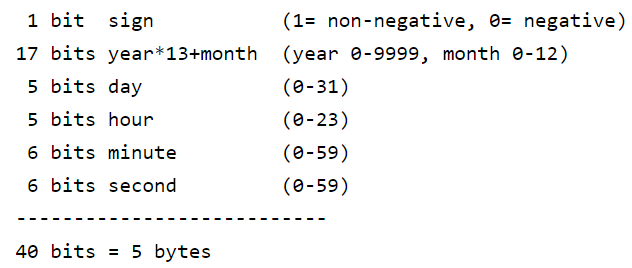mysql timestamp字段规范使用详情
作者:sdmei
1. 前言
这个世界离不开时间,同样,数据库中也是如此,表中的每条记录除了数据模型的时间字段(如生日,生产日期,出发日期等),一般至少还有两个固定的时间字段:记录插入时间,记录更新时间。
然而,看似很简单时间字段,谁能想到会导致应用报错,引发血案:

个中缘由,正是接下来要讲到的。
2. mysql中的时间字段
因时间字段的一些特性与版本有关,且目前我司统一使用的mysql 5.7版本,因此本文内容都基于mysql 5.7。
mysql时间相关的字段主要有DATE、DATETIME、TIMESTAMP。

其中datatime和timestamp字段都可以包含小数,如datetime(6),字节长度的可变部分(0-3)由小数位数决定:

2.1. 数据的存储方式
DATE:
3个字节的整型,按照这种方式进行压缩: YYYY×16×32 + MM×32 + DD
DATETIME:
整数部分5个字节,由以下部分组成

TIMESTAMP:
整数部分4个字节,存储从(‘1970-01-01 00:00:00’ UTC)到指定时间的秒数;
timestamp类型是4个字节,最大值是2的31次方减1,也就是2147483647,转换成北京时间就是2038-01-19 11:14:07
2.2. DATETIME和TIMESTMAP的区别
- 数据的存储方式决定了timestamp的计算和索引效率比datetime更快;
- timestamp存储的时间范围比datetime小很多;
- timestamp数据显示时要根据时区换算,datetime数据显示时不受时区影响;
admin@test 04:42:41>show variables like 'time_zone'; +---------------+--------+ | Variable_name | Value | +---------------+--------+ | time_zone | +08:00 | +---------------+--------+ admin@test 04:42:42>create table t1(dt datetime,ts timestamp); admin@test 04:43:07>insert into t1 values(now(),now()); admin@test 04:43:17>select * from t1; +---------------------+---------------------+ | dt | ts | +---------------------+---------------------+ | 2021-03-27 16:43:17 | 2021-03-27 16:43:17 | +---------------------+---------------------+ admin@test 04:43:50>set time_zone='+09:00'; admin@test 04:44:00>select * from t1; +---------------------+---------------------+ | dt | ts | +---------------------+---------------------+ | 2021-03-27 16:43:17 | 2021-03-27 17:43:17 | +---------------------+---------------------+ admin@test 04:44:07>
timestamp在处理默认值和null值时的行为时受mysql参数explicit_defaults_for_timestamp控制,datatime不受影响。
3. timestamp字段处理默认值和null值时的行为
3.1. 参数禁用
当禁用该值时(explicit_defaults_for_timestamp=0),mysql启用timestamp字段的特有行为(和数字、字符串等类型的表现不同),
具体特性如下:
- timestamp字段默认设置为not null
- 表中的第一个timestamp字段插入时默认设置当前时间,更新时,默认更新为当前时间,即默认设置为以下特性:NOT NULL DEFAULT CURRENT_TIMESTAMP ON UPDATE CURRENT_TIMESTAMP
- 表中的第二个timestamp字段默认为'0000-00-00 00:00:00'
- 显式向timestamp字段插入null值时,不会报错,且都设置为当前时间;
- 对datetime字段的行为无影响。
admin@test 05:49:00>create table t2(id int auto_increment, name varchar(100), dt1 datetime, ts1 timestamp, ts2 timestamp, primary key(id)); admin@test 05:49:48>show create table t2; ±------±--------------------------------------------------------------------------+ | Table | Create Table | ±------±--------------------------------------------------------------------------+ | t2 | CREATE TABLE t2 ( id int(11) NOT NULL AUTO_INCREMENT, name varchar(100) DEFAULT NULL, dt1 datetime DEFAULT NULL, ts1 timestamp NULL DEFAULT NULL, ts2 timestamp NULL DEFAULT NULL, PRIMARY KEY (id) ) ENGINE=InnoDB DEFAULT CHARSET=utf8mb4 | ±------±--------------------------------------------------------------------------+ 1 row in set (0.00 sec) admin@test 05:50:20>insert into t2(name) values(‘a1'); Query OK, 1 row affected (0.00 sec) admin@test 05:51:07>select * from t2; ±—±-----±-----±-----±-----+ | id | name | dt1 | ts1 | ts2 | ±—±-----±-----±-----±-----+ | 1 | a1 | NULL | NULL | NULL | ±—±-----±-----±-----±-----+ 1 row in set (0.00 sec) ##注:插入记录时,默认为null admin@test 05:54:20>update t2 set name=‘aa1' where id=1; Query OK, 1 row affected (0.00 sec) Rows matched: 1 Changed: 1 Warnings: 0 admin@test 05:54:31>select * from t2; ±—±-----±-----±-----±-----+ | id | name | dt1 | ts1 | ts2 | ±—±-----±-----±-----±-----+ | 1 | aa1 | NULL | NULL | NULL | ±—±-----±-----±-----±-----+ 1 row in set (0.00 sec) ##注:更新记录时,默认为null admin@test 05:58:10>create table t3(id int auto_increment,name varchar(100),ts1 timestamp not null default current_timestamp,primary key(id)); admin@test 05:58:18>insert into t3(name) values(‘a1'); Query OK, 1 row affected (0.00 sec) admin@test 05:58:22>select * from t3; ±—±-----±--------------------+ | id | name | ts1 | ±—±-----±--------------------+ | 1 | a1 | 2021-03-23 17:58:22 | ±—±-----±--------------------+ 1 row in set (0.00 sec) ##注:创建表手动设置not null default current_timestamp,插入记录不含timestamp字段时,默认为当前时间 admin@test 05:58:25>insert into t3(name,ts1) values(‘a1',null); ERROR 1048 (23000): Column ‘ts1' cannot be null ##注:timestamp字段显式插入null时,报错Column ‘ts1' cannot be null admin@test 05:59:11>create table t4(id int auto_increment,name varchar(100),ts1 timestamp not null ,primary key(id)); Query OK, 0 rows affected (0.04 sec) admin@test 05:59:44>insert into t4(name) values(‘a1'); ERROR 1364 (HY000): Field ‘ts1' doesn't have a default value admin@test 05:59:49> ##注:创建表手动设置not null,插入记录不含timestamp字段时,报错Field doesn't have a default value admin@test 05:59:50>insert into t4(name,ts1) values(‘a1',null); ERROR 1048 (23000): Column ‘ts1' cannot be null admin@test 05:59:57> ##注:timestamp字段显式插入null时,报错Column ‘ts1' cannot be null
3.2. 参数启用
当启用该值时(explicit_defaults_for_timestamp=1),mysql禁用timestamp字段的特有行为,具体表现和数字、字符串类型一样。
- timestamp字段默认属性是“NULL DEFAULT NULL”;
- timestamp字段手动设置了not null和default后,显式插入null值会报错:Column cannot be null;
- timestamp字段同时设置了not null但未设置default后,显式插入null值会报错:Column cannot be null,插入记录不含timestamp字段时会报错Field doesn’t have a default value;
- 对datetime字段的行为无影响。
admin@test 05:49:00>create table t2(id int auto_increment, name varchar(100), dt1 datetime, ts1 timestamp, ts2 timestamp, primary key(id));
admin@test 05:49:48>show create table t2;
+-------+---------------------------------------------------------------------------+
| Table | Create Table |
+-------+---------------------------------------------------------------------------+
| t2 | CREATE TABLE `t2` (
`id` int(11) NOT NULL AUTO_INCREMENT,
`name` varchar(100) DEFAULT NULL,
`dt1` datetime DEFAULT NULL,
`ts1` timestamp NULL DEFAULT NULL,
`ts2` timestamp NULL DEFAULT NULL,
PRIMARY KEY (`id`)
) ENGINE=InnoDB DEFAULT CHARSET=utf8mb4 |
+-------+---------------------------------------------------------------------------+
1 row in set (0.00 sec)
admin@test 05:50:20>insert into t2(name) values(‘a1');
Query OK, 1 row affected (0.00 sec)
admin@test 05:51:07>select * from t2;
±—±-----±-----±-----±-----+
| id | name | dt1 | ts1 | ts2 |
±—±-----±-----±-----±-----+
| 1 | a1 | NULL | NULL | NULL |
±—±-----±-----±-----±-----+
1 row in set (0.00 sec)
## 注:插入记录时,默认为null
admin@test 05:54:20>update t2 set name=‘aa1' where id=1;
Query OK, 1 row affected (0.00 sec)
Rows matched: 1 Changed: 1 Warnings: 0
admin@test 05:54:31>select * from t2;
±—±-----±-----±-----±-----+
| id | name | dt1 | ts1 | ts2 |
±—±-----±-----±-----±-----+
| 1 | aa1 | NULL | NULL | NULL |
±—±-----±-----±-----±-----+
1 row in set (0.00 sec)
## 注:更新记录时,默认为null
admin@test 05:58:10>create table t3(id int auto_increment,name varchar(100),ts1 timestamp not null default current_timestamp,primary key(id));
admin@test 05:58:18>insert into t3(name) values(‘a1');
Query OK, 1 row affected (0.00 sec)
admin@test 05:58:22>select * from t3;
±—±-----±--------------------+
| id | name | ts1 |
±—±-----±--------------------+
| 1 | a1 | 2021-03-23 17:58:22 |
±—±-----±--------------------+
1 row in set (0.00 sec)
##注:创建表手动设置not null default current_timestamp,插入记录不含timestamp字段时,默认为当前时间
admin@test 05:58:25>insert into t3(name,ts1) values(‘a1',null);
ERROR 1048 (23000): Column ‘ts1' cannot be null
##注:timestamp字段显式插入null时,报错Column ‘ts1' cannot be null
admin@test 05:59:11>create table t4(id int auto_increment,name varchar(100),ts1 timestamp not null ,primary key(id));
Query OK, 0 rows affected (0.04 sec)
admin@test 05:59:44>insert into t4(name) values(‘a1');
ERROR 1364 (HY000): Field ‘ts1' doesn't have a default value
admin@test 05:59:49>
##注:创建表手动设置not null,插入记录不含timestamp字段时,报错Field doesn't have a default value
admin@test 05:59:50>insert into t4(name,ts1) values(‘a1',null);
ERROR 1048 (23000): Column ‘ts1' cannot be null
admin@test 05:59:57>
##注:timestamp字段显式插入null时,报错Column ‘ts1' cannot be null4. 总结
启用该参数(explicit_defaults_for_timestamp=1)
timestamp字段在null、default属性的表现和其他普通字段表现类似:
- 如果没有显式设置default值,该值的维护完全需要应用程序显式插入和更新;
- 如果设置了not null,那么一定不能显式插入null值,否则应用会报错。
禁用该参数(explicit_defaults_for_timestamp=0)
timestamp字段在null、default属性的表现和其他普通字段表现有明显差异:
- 默认会设置NOT NULL DEFAULT CURRENT_TIMESTAMP ON UPDATE CURRENT_TIMESTAMP;
- 显式插入null值,默认为当前时间,应用不会报错。
案例发生的场景:
公司所有集群已经统一启用该参数;
某集群过去某个时间因为研发的要求,将该参数禁用,但是这次集群切换后的新服务器采用了统一的参数模板,启用了参数;
应用程序显式向timestamp字段插入null值,且该字段已经设置了not null,在禁用该参数的集群不会报错,但是切换到启用了该参数的集群时,就报column cannot be null.
统一规范:
个别集群禁用该参数导致公司所有的mysql集群参数不统一,可能带来应用报错的后果,因此建议:
- 统一公司所有集群的参数explicit_defaults_for_timestamp=1;
- 用timestamp字段时设置default和not null属性;
- 应用程序不要显式插入null值。
到此这篇关于mysql timestamp字段规范使用详情的文章就介绍到这了,更多相关mysql timestamp字段 内容请搜索脚本之家以前的文章或继续浏览下面的相关文章希望大家以后多多支持脚本之家!
